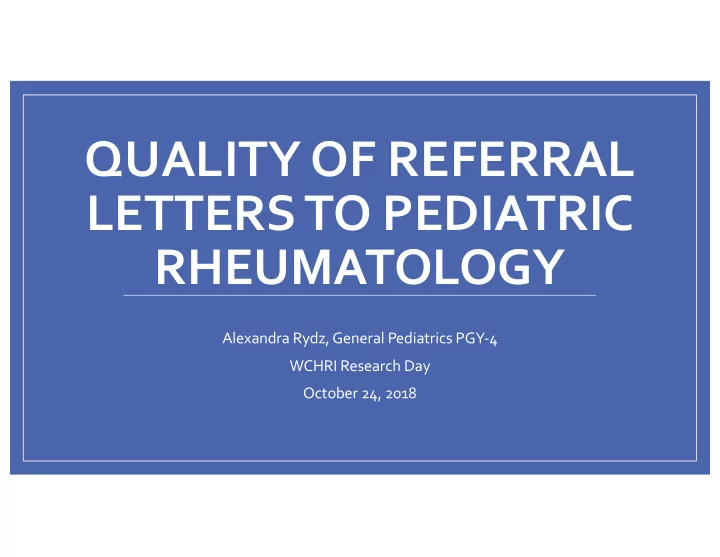

QUALITY OF REFERRAL LETTERS TO PEDIATRIC RHEUMATOLOGY Alexandra Rydz, General Pediatrics PGY-4 WCHRI Research Day October 24, 2018
Background: the problem Arthritis Alliance of Canada recommendations: JIA identification and • treatment within 4 weeks of health care interaction Delays in access to care have significant impacts • Delays in accessing care are well documented (Foster et al. 2007, Shiff et • al. 2009) Factors contributing to delays are multifactorial (Shiff et al. 2010, • Tzaribachev et al. 2009)
Background: referral letters Referral letters are important • Alberta Health Services is promoting a Quality Referral Evolution initiative • Referral letters are notoriously lacking in details • Quality of referral letters to pediatric rheumatology (PR) is unknown •
Our questions Who is referring to pediatric rheumatology? • What is the quality of referral letters to pediatric rheumatology? • What information is being included? What is lacking? • Is there an impact on time to access to care? •
Box 1. Components of a high quality referral Methods letter 1. Diagnosis of concern 2. Symptoms Inclusion criteria: all new referrals to a tertiary • 3. General physical care PR service exam Exclusion criteria: >17 years old; previously 4. Musculoskeletal • followed by PR; referral declined physical exam 5. Investigations Prospective review for 8 components of a high • 6. Current and past quality referral (Box 1) medical conditions Documentation of: basic patient demographics, • 7. Co-morbidities referring physician specialty, dates of triage 8. Current medications decisions, date of PR visit and ultimate diagnoses For incomplete referrals: delay in triage time • Application of descriptive statistics •
Results 536 letters received • Figure 1. Providers referring to PR 447 eligible referrals were reviewed • 13.4 63 of these (14%) required further • information to assist with triage 45.2 41.4 Family doctors Pediatric Providers Others
Results Figure 2: Frequency of quality referral letters components included in letters to PR 100 90 80 70 60 50 40 30 20 10 0 General exam Co-morbidities Dx of concern Symptoms Investigations MSK exam Management Medications RLs for which further information was requested RLs immediately triaged All included RLs
Results Most frequently requested information: pertinent history (91%), physical • examination (92%), rheumatologic diagnosis of concern (70%) Requesting information resulted in median delay in time to triage of 1.0 • week (IQR 0.1 – 2.0) 188/447 (42%) referrals resulted in a rheumatic diagnosis • 101/447 (23%) diagnosed with JIA • Median time to first visit for those with JIA, triaged immediately: 6.9 weeks • (IQR 3.6 to 11.1) Median time to first visit for those with JIA, delayed triage: 11.1 weeks (IQR • 9.3 to 20.1) More referrals from pediatric providers result in rheumatic diagnosis than • referrals from family physicians (48.6% vs 36.6%, p = ***)
Discussion Patient symptoms and physical examination were the most commonly • requested information This is consistent with findings at other rheumatologic centres (Graydon and • Thompson 2008) There is a documented lack of confidence with MSK exams among clinicians • (Hergenroeder et al., 2001; Jandial et al., 2009) Missing components of history and/or physical examination may indicate lack • of familiarity with PR diseases Less than half of referrals resulted in true rheumatic diagnosis • MSK complaints are a frequent presentation to family doctors (Wiitavaara, • Falhstrom & Djupsjöbacka 2017) Specialty of referring provider has a significant impact may reflect training • exposure
Discussion Requesting missing information resulted in delayed triage • Even those being triaged immediately do not meet Arthritis Alliance of • Canada’s recommendation Future directions • Providing education to both pediatric and non-pediatric providers around both • PR conditions and impact of incomplete referrals on time to assessment Promoting use of referral management systems that mandate input of • specific data may be beneficial
Thank you for your attention!
Acknowledgements Fangfang Fu Mark Drew Mercedes Chan Yan Yuan Dax Rumsey
References Foster HE, Eltringham MS, Kay LJ, Friswell M, Abinun M, Myers A. Delay in access to appropriate care for children presenting with musculoskeletal symptoms and ultimately diagnosed with juvenile idiopathic arthritis. Arthritis Care & Research . 2007; 57(6): 921-927. GraydonS.L., & Thompson, A. E. (2008). Triage of referrals to an outpatient rheumatology clinic: Analysis of referral information and triage. Journal of Rheumatology, 35 (7), 1378-1383. HergenroederAC, Chorley JN, Laufman L, FetterhoffAC. Pediatric Residents' Performance of Ankle and Knee Examinations After an Educational Intervention. American Academy of Pediatrics. 2001; 107(4): E52 Jandial S, Myers A, Wise E, Foster HE. Doctors likely to encounter children with musculoskeletal complaints have low confidence in their clinical skills. The Journal of Pediatrics . February 2009; 154(2): 267-71. Shiff NJ, Abdwani R, Cabral DA, et al. Access to Pediatric Rheumatology Subspecialty Care in British Columbia, Canada. The Journal of Rheumatology . 2009; 36(2): 410-415. Shiff NJ, Tucker LB, Guzman J, Oen K, Yeung RSM, Duffy CM. Factors Associated with a Longer Time to Access Pediatric Rheumatologists in Canadian Children with Juvenile Idiopathic Arthritis. The Journal of Rheumatology . November 2010; 37(11): 2415-2421. Tzaribachev N, Benseler SM, Tyrrell PN, Meyer A, Kuemmerle-deschner JB. Predictors of delayed referral to a pediatric rheumatology center. Arthritis Care & Research . 2009; 61(10): 1367-1372. Wiitavaara, B., Falhstrom, M., & Djupsjobacka, M. (2017). Prevalence, diagnostics and management of musculoskeletal disorders in primary health care in Sweden – an investigation of 2000 randomly selected patient records. Journal of evaluation in clinical practice, 23(2): 325-332
Appendix A: Referral letters undoing analysis
QoL checklist Box 1. Components of a high quality referral letter 1. Diagnosis of concern 2. Symptoms 3. General physical exam 4. Musculoskeletal physical exam 5. Investigations 6. Current and past medical conditions 7. Co-morbidities 8. Current medications
Ultimate diagnoses Non- PR Diagnoses # / 259 Arthralgia/ mechanical joint 56 pain Patellofemoral syndrome 31 Pain amplification syndrome 17 Acrocyanosis/ digit swelling 16 Benign hypermobility + pes 15 planus Well child 12 Chronic pain 10 Growing pain 7 Primary Raynaud’s 7 Other 88
Recommend
More recommend